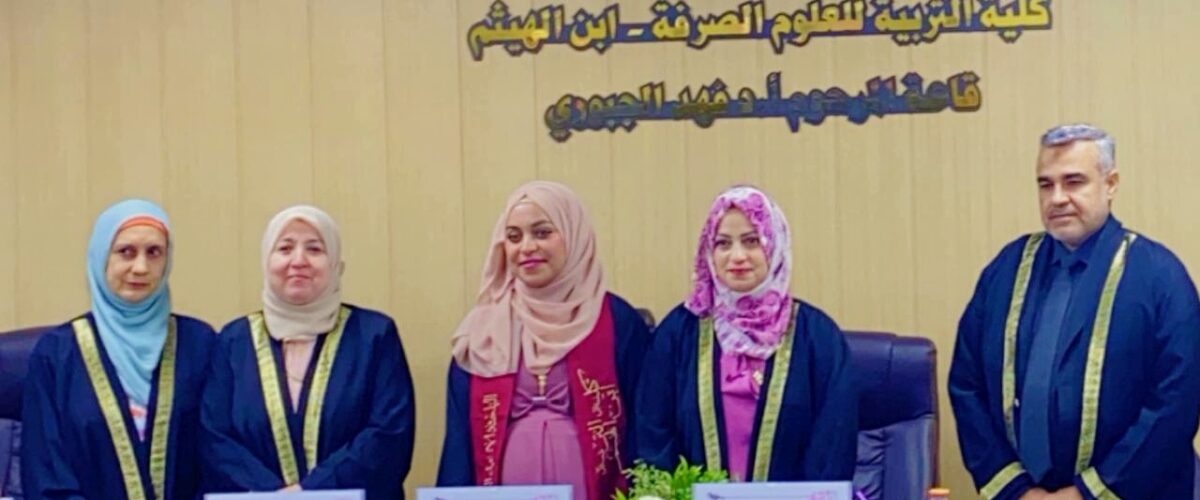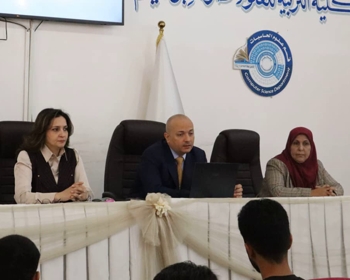ناقش قسم الكيمياء في كلية التربيةللعلوم الصرفة (ابن الهيثم) رسالة الماجستير الموسومة ” تقدير بعض المؤشرات الكيموحيوية في مرض الكبد الدهني غير الكحولي كمضاعفات مع مؤشر كتلة الجسم ” للطالبة ” الاء عبد الستار فارس ” التي انجزتها تحت اشراف التدريسية في القسم ” أ.م.د. وركاء طعمة سلوم ” ونوقشت من قبل أعضاء لجنة المناقشة المبينة أسمائهم في ما يأتي :
-
أ.د. انوار فاروق مسلم – رئيسا
-
أ.م.د. نورهان خالد شفيق – رئيسا
-
أ.م.د. رائد جاسم محمد – رئيسا
-
أ.م.د. وركاء طعمة سلوم – عضوا ومشرفاً
وهدفت هذه الدراسة إلى تحديد مستويات كل من إيريسين ، فيزفاتين ، RBP4 ، أديبونكتين ، فيتامين أ ، فيتامين د 3 ، ومقاييس بشرية والسمات السريرية (العمر ، مؤشر كتلة الجسم ، الدهون )الكولسترول ، HDL ،TG ،LDL ،VLDL ) ومستويات إنزيمات الكبد )GOT و GPT و ALP ) في مرضى NAFLD البدناء وغير البدناء لمقارنة النتائج مع مجموعة التحكم (االصحاء(.
تم في هذه الدراسة جمع جميع حالات الدراسة من مستشفى أمراض الجهاز الهضمي والكبد التعليمي واستشارية مستشفى بغداد داخل دائرة المدينة الطبية.
تم قياس المؤشرات الكيموحيوية المذكورة بطريقة القياس الطيفي بواسطة تقنية ELISA الاديبونكتين ، الايرسين ، فيزفاتين ، RBP4 حيث تم قياسهن بواسطة تقنية ELISA الشطيرية ، بينما تم قياس مستويات الفيتامينات ا و د 3 بواسطة تقنية الاليزا التنافسية .
تضمنت هذه الدراسة 90 عينة موزعة على ثلاث مجموعات:
-
الأولى (G1) تضمنت (34) مريضاً يعانون من السمنة NAFLD.
-
المجموعة الثانية (G2) وضمت (26) مريض غير مصاب بالسمنة ومصاب بمرض الكبد الدهني غير الكحولي.
-
المجموعة الثالثة (G3) كعنصر تحكم صحي. تراوحت أعمار العينات بين (22-58) و (22-50) و (22-60) سنة للمقاييس G1 و G2 و G3 على التوالي.
وخلصت نتائج هذه الدراسة إلى أن:
-
زيادة في مستوى المصل من إيريسين ، أديبونيكتين ، RBP4 و فيزفاتين في G1 و G2 مقارنة مع G3
-
انخفض مستوى الفيتامينات (ا و د3) في G1 و G2 مقارنة مع G3.
-
انخفض مستوى مصل AST و ALT و ALP في G1 بينما ارتفع في G2.
-
كان مستوى الكوليسترول في الدم ، الدهون الثلاثية و الكولسترول المنخفض الكثافة أعلى في G1 و G2 مقارنة مع G3.
-
كان مستوى الكوليسترول عالي الكثافة في الدم أقل في G1 و G2 مقارنة مع G3.
-
زيادة مستوى الكوليسترول ذو الكثافة المنخفضة جدا في الدم فيG2 الدم مقارنة مع G1 و G3.
وخلصت نتائج هذه الدراسة إلى أن مستويات (أديبونيكتين ، إيريسين ، فيزفاتين وبروتين رابط ريتينول 4 (RBP4)) زادت في G1 ، G2 مقارنة بالأصحاء. انخفضت مستويات فيتامين أ ، د 3 في G1 ، G2 مقارنة بالأشخاص الأصحاء. زيادة مستوى المؤشرات البيوكيميائية المذكورة وكذلك نقص فيتامين D3 يرتبط ارتباطًا وثيقًا بمؤشر كتلة الجسم (السمنة) حيث يكون مؤشر كتلة الجسم المرتفع عامل خطر ويرتبط بـ NAFLD ، مما يزيد من الاصابه بمرض NAFLD.
في ضوء النتائج اوصت الطالبة الباحثة بـ :
-
دراسة ارتباط مرض الكبد الدهني غير الكحولي مع امراض اخرى مثل خلل الغدة الدرقية.
-
تناول الفيتامينات ا ود كمكملات غذائية ترفع مناعة الجسم ضد الاصابة ب مرض الكبد الدهني غير الكحولي.
-
جمع بيانات من مختلف مناطق العراق وجعل النتائج اكثر دقة .
-
قياس مؤشرات ل مرض الكبد الدهني غير الكحولي مث الايرسين والاديبونكتين ومقارنة النتائج مع نتائج هذه الدراسة.
-
دراسة دور الاديبو نكتين في مرض الكبد الدهني غير الكحولي مع وبدون السكري من النوع الثاني في عمر 40 عام واكثر.
-
العمل على دراسات تحليلية بعدية عن مرض الكبد الدهني غير الكحولي بدئا من بداية المرض وحتى المراحل المتاخره منه .
-
دراسة دور الفزفاتين في مرض الكبد الدهني غير الكحولي مع امراض القلب .
Evaluation of Some Biochemical Parameters in Non Alcoholic Fatty Liver Disease As A Complication With Body Mass Index
By Alaa Abdulsatar Faris
Supervised by Ass. Prof. Dr.Warka’aTumaSaloum
The aim of the research:
This study aim is the determination of irisin, visfatin, RBP4, adiponectin, vitamin A, vitamin D3, anthropometric and clinical features (age, BMI, lipid profile(cholesterol, HDL,TG,LDL,VLDL) and liver enzyme (GOT,GPT and ALP) levels in patients with obese and Non obese NAFLD to compare the results with control group.
Abstract
Background: Non-Alcoholic Fatty Liver Disease (NAFLD) is one of the most common public liver diseases and about 25% of the population over the world. NAFLD is known as a commutation of excessive fat (> 5%) as triglycerides form (steatosis) in the liver by excluding alcohol consuming.
Aim of the study :This study aim is the determination of irisin, visfatin, RBP4, adiponectin, vitamin A, vitamin D3, anthropometric and clinical features (age, BMI, lipid profile(cholesterol, HDL,TG,LDL,VLDL) and liver enzyme (GOT,GPT and ALP) levels in patients with obese and Non obese NAFLD to compare the results with control group.
Subjects, Materials and Methods: all study cases were collected from the Gastroenterology and Liver Teaching Hospital and Baghdad Hospital Consultation within the Medical City Department. The mentioned biochemical indicators were measured spectrophotometrically by ELISA technique (adiponectien, irisin, visfatien and Retinol binding protein 4 (RBP4)) where measured by the sandwich ELISA technique, while the levels of vitamins (A and D3) were measured by the competitive ELISA technique.
This study including ninety samples which distributed into three groups:1-First one (G1) contained of (34) patients of obese NAFLD.
2-Second group (G2) contained of (26) patients of non obese NAFLD.
3-Third group (G3) as a healthy control. The age of samples range were (22 to58), (22 to 50) and (22 to 60) years for G1, G2 and G3 respectively.
Results: the results of this study concluded that:
1-Increase in serum level of irisin, adiponectien,RBP4 and visfatien in G1 and G2 compared with G3.
2-The level of vitamins (A and D3) dropped in G1and G2 compared with G3.
3-The level of serum AST, ALT and ALP dropped in G1 while increase in G2.
4-The level of serum cholesterol , TG and LDL was higher in G1 and G2 compared with G3.
5- The level of serum HDL- cholesterol was lower in G1 and G2 compared with G3.
6- Serum VLDL- cholesterol level showed increasing in G2 compared with G1 and G3.
Conclusions: The results of this study concluded that the levels of (adiponectien, irisin, visfatien and Retinol binding protein 4 (RBP4)) increased in G1, G2 compared to healthy subjects. Vitamin A, D3 levels decreased in G1, G2 compared to healthy subjects. Increased the level of mentioned biochemical indicators as well as vitamin D3 deficiency is closely related to body mass index (obesity) where the high BMI is a risk factor and associated with NAFLD, which increases the incidence of NAFLD disease.
In light of the results, the researcher recommends :
– Study the association between NAFLD with other diseases such as thyroid dysfunction.
– Taking vitamin A and D as supplements that raise the body’s immunity against NAFLD.
– Collect samples from different places in Iraq and expanded more accurate results.
– Measurement of parameters for NAFLD such as (irisin and adiponectin) and compare results with results of this study.
– Study role of adiponectin in NAFLD with and without T2D in age 40 and above.
– Work on more analytical studies (Meta analysis) about NAFLD start from beginning of the disease even the late stages.
– Study role of visfatin in NAFLD with cardiovascular disease










